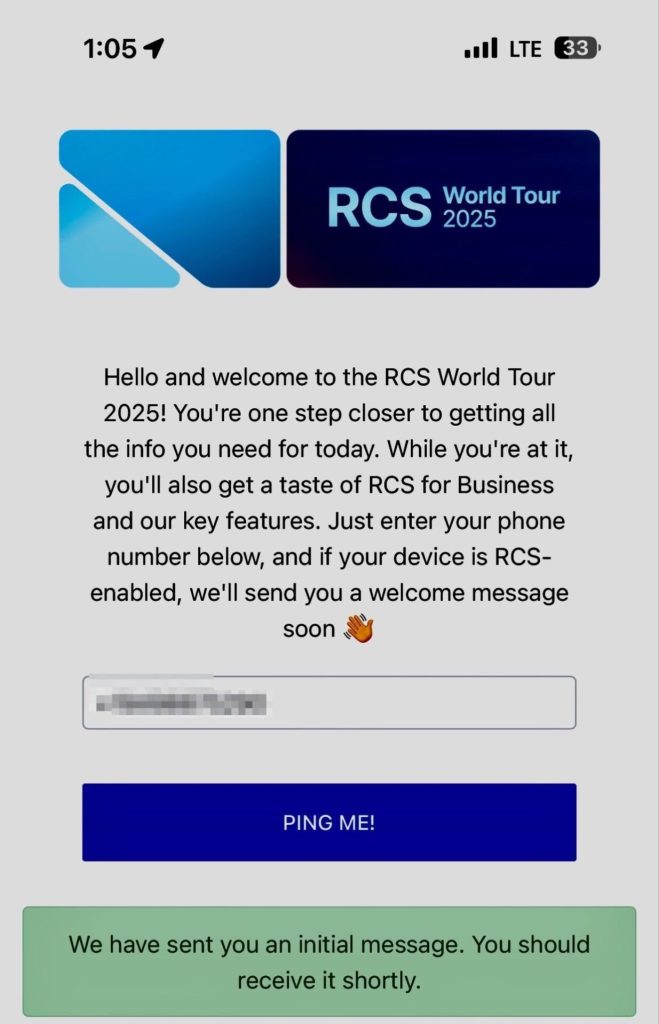Table of Contents
“Rich as an app, simple as a text.”
We’ve seen other foundational technologies endure their long winters, most recently crypto and machine learning. T-Mobile’s Kara Henry’s closing line could well mark the official end of the RCS winter.
RCS World in New York this week was a declaration that RBM has finally arrived in the US. The industry showed up in force. On stage were messaging leads from every major carrier. Joining Kara were Debbie Rebell of Verizon, Jason Kaufman of AT&T, and Alastair Slattery ofGoogle. In the audience were Sinch’s Laurinda Pang, Infobip’s Silvio Kutić, Bandwidth’s David Morten, and Vibes’ Jack Philbin.

The turnout also showed Google’s convening power.
The event must have been a quiet affirmation for Elmar Weber (also the keynote), Google’s GM for Android & Business Communication.

As one of the Jibe founders and CTO, Elmar has been at it longer than most in the industry. It’s rumored that in the early days, the entire RBM/Jibe server once sat on a PC under his desk. The long game definitely pay off.
After years of patient stops and starts (I’d love to read the original memo Alastair wrote asking for Google’s investment in RCS), the winds have finally shifted.
The Abundant Optimism
The atmosphere was like MWC Los Angeles in 2018, when everyone was excited about what it could be. Back then, like the ADP use case my team helped build, there were demos, but they worked only on Sprint. Without universal device and carrier support, the real wins remained stuck in demo mode.
This time it felt like version 2.0. The crowd just as big and energized, the use cases just as substantive and bold. But this time, RCS can scale. It is finally a medium brands can build on and platforms can enable.
The Practical Learnings
The brands weren’t afraid to fail, but that didn’t mean they were careless. They chose use cases that had either never been on messaging before or hadn’t performed well on messaging. And the results were revelatory.

The LA Rams example proved that RCS has the cross-generational appeal of SMS. The team picked the NFL Schedule Release event to build a carousel experience where fans could buy tickets for a specific game. This was only possible in RCS, but like a web experience, you could track which games were popular with the fans. Across the board, engagement rose 60%. This was a new use case—a new experience—that worked everywhere RCS did.

IHG’s customer experience use case was a new product that Google calls tap to message. If you google IHG Hotels, displayed next to the 1-800 number is a tap to chat link. This will crank up your messaging app, which will then allow you to go back and forth with the brand via text. This is the classic last-tap solution with outsized impact on customer satisfaction and thereby loyalty. Not only is it moving customers away from expensive (and annoying) call waits but also providing a richer, more relaxed conversational experience.
The Unspoken Challenges
Google’s Pier 57 office on a sunny New York day would make anyone smile. Add a festive atmosphere, smoothly MC’d by Google’s Alex Allemand, and you’d think there was little to ponder. But there were still hiccups.

The audience demo worked, but here’s the catch: The use case required the audience to scan a QR code that opened a webpage, which then initiated an RCS message to the device. It worked beautifully—except on iOS, where it promptly delivered the message under Unknown Senders.


Therein lies the issue with Apple’s inbox upgrade. It’s not that the experience changed but that the change is incomplete. I clearly requested the RCS message, and Apple still treated it as an unknown sender because it didn’t know anything outside of its ecosystem. Technically the shortcoming is understandable, but still is an unfortunate product experience.
The Work in Progress
The conference had many original pioneers taking a well-earned bow and early innovators showing off strong use cases. But there is still work to be done.
First, if RCS’s secret sauce is conversation—Discovery, Engagement, Conversion, Post-Purchase Support, and Re-Engagement—then there has to be a ground-up conversational product that the industry can sell. And that product needs to include some form of unlimited pricing so a chatty customer doesn’t also become an expensive one.
Second, a company can now harness its brand power in the most impactful messaging medium modern communications knows. In this world, who gets to use the brand; and how that data is collected, collated, verified, and vetted is critical.
But the onboarding process remains confusing. The buy button is still a fill-out-this-form, talk-to-us web flow. This is not scalable.
You don’t have to look further than the recent AWS outage to see how something as seemingly innocuous as a registry can bring an entire network to its knees. If RCS is to reach mass-market potential, the industry must prioritize scaling the KYC/KYB process flow.
Finally
The event was like a perfect Coca-Cola ad: confident, festive, and optimistic. But if you listened to the conversations on and off stage, there was little doubt that the real hard work lies ahead. We’re entering a new era of US messaging, where who gets to say they’re Coca-Cola now matters more than how they say it.